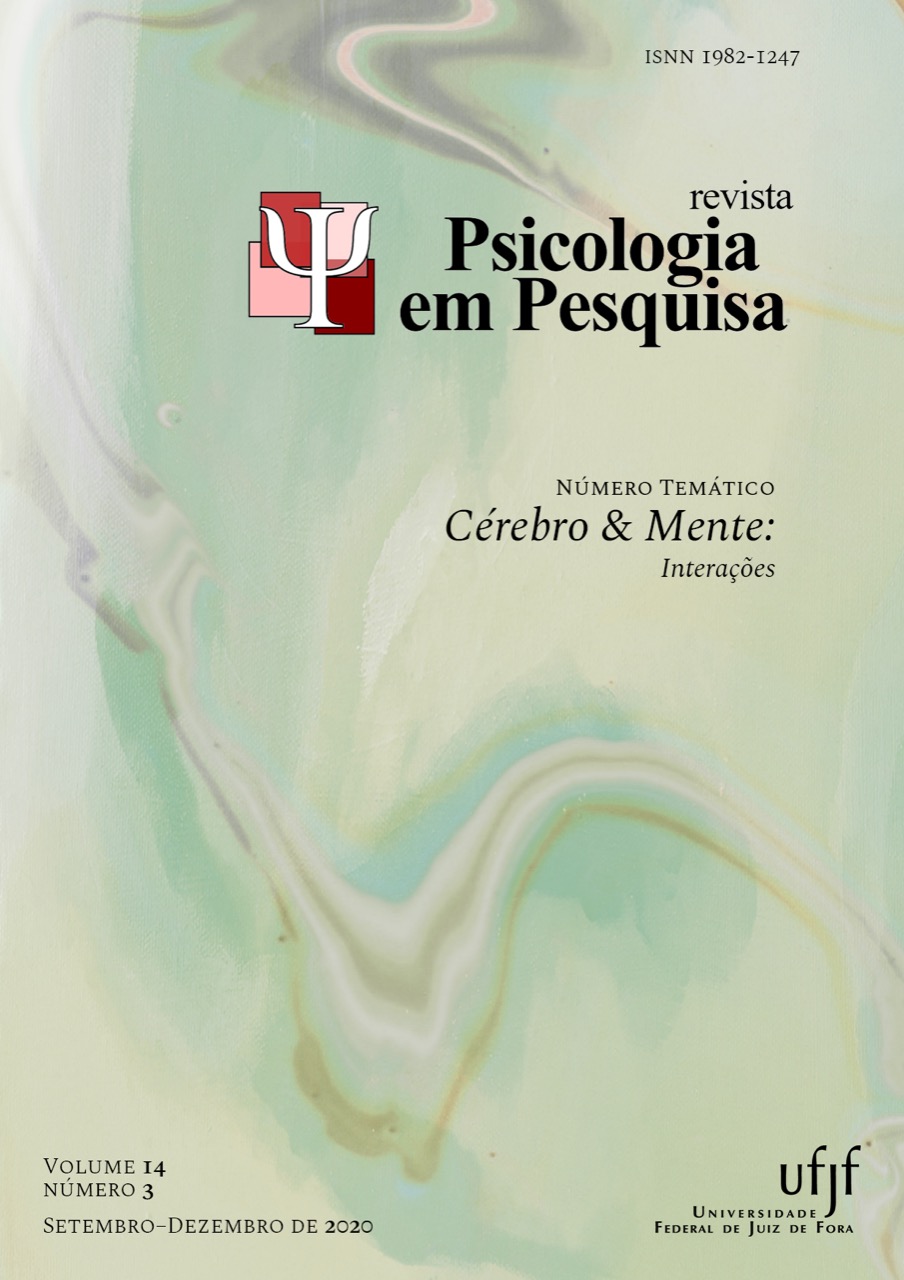Modelo Multinomial Aplicado a la Investigación Psicológica
DOI:
https://doi.org/10.34019/1982-1247.2020.v14.29542Palabras clave:
Modelo matemático, Processos latentes, Distribución multinomial, Processos estocásticos, Estados mentalesResumen
Teorías sobre fenómenos psicológicos a menudo se refieren a procesos que no son directamente observables (procesos latentes). Sin embargo, la investigación de estos fenómenos se realiza tradicionalmente de manera indirecta con respecto a los procesos latentes. El propósito de este artículo es presentar los conceptos fundamentales del modelado multinomial. Aquí mostramos cómo los modelos de procesos latentes se derivan de modelos puramente descriptivos al reducir el espacio de parámetros motivado por una o más teorías psicológicas. El resultado son modelos multinomiales que proporcionan medidas simples de procesos psicológicos (probabilidades) y que pueden probarse cuantitativamente con datos reales. El uso de modelos multinomiales permite el análisis directo de los efectos de variables independientes en los procesos latentes que controlan el rendimiento en una o más tareas experimentales, lo que facilita la prueba de predicciones y explicaciones teóricas sobre fenómenos psicológicos.
Descargas
Citas
Bamber, D., & van Santen, J. P. (1985). How many parameters can a model have and still be testable?. Journal of Mathematical Psychology, 29, 443-473.
Bamber, D., & van Santen, J. P. (2000). How to assess a model's testability and identifiability. Journal of Mathematical Psychology, 44, 20-40.
Batchelder, W. H., & Riefer, D. M. (1986). The statistical analysis of a model for storage and retrieval processes in human memory. British Journal of Mathematical and Statistical Psychology, 39, 129–149.
Batchelder, W. H., & Riefer, D. M. (1999). Theoretical and empirical review of multinomial process tree modeling. Psychonomic Bulletin & Review, 6, 57-86.
Brainerd, C. J., Gomes, C. F. A., & Moran, R. (2014). The two recollections. Psychological Review, 121, 563-599.
Brainerd, C. J., Reyna, V. F., & Mojardin, A. H. (1999). Conjoint recognition. Psychological Review, 106, 160-179.
Bröder, A., & Schütz, J. (2009). Recognition ROCs are curvilinear—or are they? On premature arguments against the two-high-threshold model of recognition. Journal of Experimental Psychology: Learning, Memory, and Cognition, 35, 587-606.
Buratto, L. G., Gomes, C. F. D. A., Prusokowski, T. D. S., & Stein, L. M. (2013). Inter-item associations for the Brazilian version of the Deese/Roediger-McDermott paradigm. Psicologia: Reflexão e Crítica, 26, 367-375.
Cressie, N., & Read, T. R. (1984). Multinomial goodness‐of‐fit tests. Journal of the Royal Statistical Society: Series B (Methodological), 46, 440-464.
Erdfelder, E., Auer, T. S., Hilbig, B. E., Aßfalg, A., Moshagen, M., & Nadarevic, L. (2009). Multinomial processing tree models: A review of the literature. Zeitschrift für Psychologie/Journal of Psychology, 217, 108-124.
Gomes, C. F., Brainerd, C. J., & Stein, L. M. (2013). Effects of emotional valence and arousal on recollective and nonrecollective recall. Journal of Experimental Psychology: Learning, Memory, and Cognition, 39, 663-677.
Gross, J. L., & Yellen, J. (Eds.). (2003). Handbook of graph theory. CRC press.
Heck, D. W., Arnold, N. R., & Arnold, D. (2018). TreeBUGS: An R package for hierarchical multinomial-processing-tree modeling. Behavior Research Methods, 50, 264-284.
Heck, D. W., & Erdfelder, E. (2016). Extending multinomial processing tree models to measure the relative speed of cognitive processes. Psychonomic Bulletin & Review, 23, 1440-1465.
Hu, X., & Batchelder, W. H. (1994). The statistical analysis of general processing tree models with the EM algorithm. Psychometrika, 59, 21–47.
Hu, X., & Phillips, G. A. (1999). GPT. EXE: A powerful tool for the visualization and analysis of general processing tree models. Behavior Research Methods, Instruments, & Computers, 31, 220-234.
Kellen, D., & Klauer, K. C. (in press). Selecting amongst multinomial models: An apologia for normalized maximum likelihood. PsyArXiv.
Klauer, K. C. (2010). Hierarchical multinomial processing tree models: A latent-trait approach. Psychometrika, 75, 70–98.
Klauer, K. C., & Kellen, D. (2018). RT-MPTs: Process models for response-time distributions based on multinomial processing trees with applications to recognition memory. Journal of Mathematical Psychology, 82, 111-130.
Knapp, B. R., & Batchelder, W. H. (2004). Representing parametric order constraints in multi-trial applications of multinomial processing tree models. Journal of Mathematical Psychology, 48, 215-229.
Lehman, M., & Malmberg, K. J. (2013). A buffer model of memory encoding and temporal correlations in retrieval. Psychological Review, 120, 155-189.
Matzke, D., Dolan, C. V., Batchelder, W. H., & Wagenmakers, E. J. (2015). Bayesian estimation of multinomial processing tree models with heterogeneity in participants and items. Psychometrika, 80, 205-235.
Miles, M. B., Huberman, A. M., & Saldaña, J. (2014). Qualitative data analysis: A methods sourcebook. Thousand Oaks, CA: Sage.
Moshagen, M. (2010). multiTree: A computer program for the analysis of multinomial processing tree models. Behavior Research Methods, 42, 42-54.
Myung, I. J. (2003). Tutorial on maximum likelihood estimation. Journal of Mathematical Psychology, 47, 90-100.
R Core Team (2020). R: A Language and Environment for Statistical Computing. R Foundation for statistical computing, Vienna.
Ratcliff, R., Gomez, P., & McKoon, G. (2004). A diffusion model account of the lexical decision task. Psychological Review, 111, 159-182.
Read, T. R., & Cressie, N. A. (2012). Goodness-of-fit statistics for discrete multivariate data. Springer Science & Business Media.
Riefer, D. M., & Batchelder, W. H. (1988). Multinomial modeling and the measurement of cognitive processes. Psychological Review, 95, 318–339.
Rouder, J. N., & Batchelder, W. H. (1998). Multinomial models for measuring storage and retrieval processes in paired associate learning. Recent progress in mathematical psychology: Psychophysics, knowledge, representation, cognition, and measurement, 195-225.
Singmann, H., & Kellen, D. (2013). MPTinR: Analysis of multinomial processing tree models in R. Behavior Research Methods, 45, 560-575.
Smith, J. B., & Batchelder, W. H. (2010). Beta-MPT: Multinomial processing tree models for addressing individual differences. Journal of Mathematical Psychology, 54, 167–183.
Stahl, C., & Klauer, K. C. (2007). HMMTree: A computer program for latent-class hierarchical multinomial processing tree models. Behavior Research Methods, 39, 267-273.
Walker, G. M., & Hickok, G. (2016). Bridging computational approaches to speech production: The semantic–lexical–auditory–motor model (SLAM). Psychonomic Bulletin & Review, 23, 339-352.
Wu, H., Myung, J. I., & Batchelder, W. H. (2010). Minimum description length model selection of multinomial processing tree models. Psychonomic Bulletin & Review, 17, 275-286.















